
Original Link: https://www.anandtech.com/show/2149
Intel Core 2 Duo E4300: Affordable and Highly Overclockable
by Anand Lal Shimpi on January 10, 2007 2:45 AM EST- Posted in
- CPUs
Last year saw the most exciting changing of the guard with processors since the introduction of AMD’s K7 core in 1999. Thanks to very solid competition from AMD over the previous few years, Intel’s introduction of the Core 2 Duo lineup of processors meant much higher performance at very reasonable prices. In fact, the near-launch availability of Core 2 Duo E6400 and E6300 CPUs meant that for less than $300 you could get performance better than previous generation Extreme Edition and FX series processors.
After the initial Core 2 launch, we didn’t see too much more from Intel, other than the late-year release of Intel’s quad-core Kentsfield processors. Earlier this week Intel introduced its second quad-core part, the Core 2 Quad Q6600 priced at $851 for a slightly more affordable entry to the quad-core market. While we won’t see anything quite as interesting as the Core 2 launch for a while now, Intel isn’t remaining quiet this year when it comes to processor releases.
1333MHz FSB processors
Intel’s chipset and CPU release schedules are very tightly integrated, and 2007’s roadmap is no different. Intel has made a habit of releasing a new family of chipsets every year, and this year’s update in Q2 will mainly bring about support for the 1333MHz FSB.
CPU performance and more recently, the number of cores per chip, have gone up drastically in recent years; the slowest Core 2 processors are more powerful in many cases than the fastest of the Pentium 4 line. Despite the quick ramp in performance and number of cores, FSB bandwidth has remained stagnant. In Q2 Intel will introduce Core 2 models ending in the number 50 (e.g. Core 2 Duo E6850, E6750 and E6650) that take advantage of the 1333MHz FSB. Both 1066MHz and 1333MHz versions will coexist as the newer cores will only officially be supported on Intel’s upcoming x35 series of chipsets.
4MB L2 across the board for the 6000 series
Another significant update coming in Q2 is that the low end 6000 series Core 2 Duo processors will receive 4MB L2 caches like their more expensive brethren. Currently the E6300 and E6400 both have 2MB L2s, but both chips will be replaced by 4MB versions - the E6320 and E6420 respectively. Clock speeds and other details won’t change, but performance will obviously increase. The best part of it all is that pricing won’t change either, so if you’re contemplating buying an E6300 or E6400 you’d be better off waiting a quarter so you can get the extra cache for free.
Introducing the 4000 series
With the E6420 and E6320 getting 4MB L2s, there's now room for a lower end Core 2 Duo SKU with a 2MB L2 cache again: enter the Core 2 Duo E4000 series. Due to launch this month, the Core 2 Duo E4300 will eventually be followed by the Core 2 Duo E4400 (released in Q2). Both are dual core offerings like their 6000 series siblings, but differentiate themselves by only featuring a 2MB L2 cache, lower clock speeds, 800MHz FSB and feature no support for Intel Virtualization Technology. However, given that VT isn't anywhere near being a mainstream requirement, the E4000 series ends up being a cheap way of getting Core 2 Duo performance.
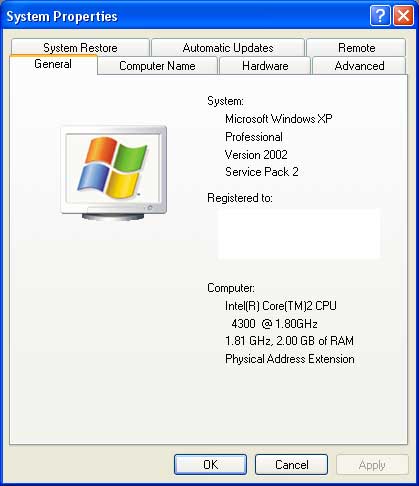
The E4000 series is based on Intel's Allendale core, not Conroe, so there's physically only 2MB of cache on the die itself (not 4MB with half of the cache disabled). The end result is that these chips are cheaper to make, cooler running and should be pretty overclockable.
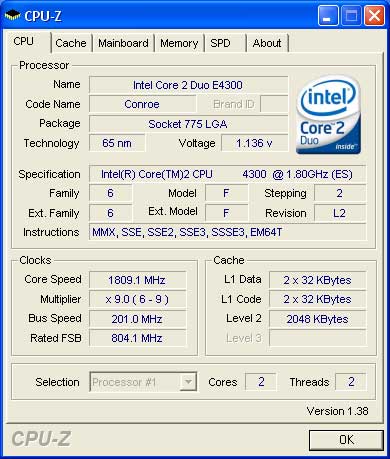
The E4300 will launch first at 1.80GHz (200MHz x 9.0), followed by the E4400 at 2.0GHz (200MHz x 10.0). Since the clock multiplier is fixed at 9.0, the only hope for overclocking is by increasing the FSB frequency. With such a low default clock multiplier, you can actually overclock the chip pretty easily.
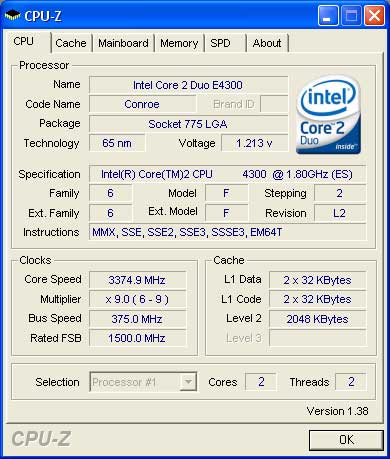
Using Gigabyte's GA-965P-DS3 motherboard, our engineering sample was able to run at 3.375GHz (375MHz x 9.0) at 1.468V using a stock Intel cooler. Although the E4300 still only has a 2MB L2 cache, when overclocked to over 3.3GHz you end up with a chip that's faster than Intel's Core 2 Extreme X6800 - at only $163. The E4300 gets even better in Q2 when its price will drop from $163 to $133, making it even more of a bargain.
The Test
Today's review will focus on the overall performance of the E4300 at stock speeds as well as when overclocked. At stock speeds the E4300 is priced as a cheaper alternative to the Core 2 Duo E6300 and AMD's Athlon 64 X2 3800+, thus the comparison between those two chips is obvious. When overclocked however, the E4300 can hang with the best of the best and thus you'll see comparisons all the way up to the X6800 and Athlon 64 X2 5000+.
We wanted to showcase the performance potential of the E4300 without resorting to more expensive 1066MHz or faster memory and thus we used a 2:1 memory-to-FSB ratio at stock speeds (DDR2-800) and 1:1 ratio for overclocking, resulting in our memory running at DDR2-750. With more expensive memory the overclocked E4300 would perform even better but our focus was on best bang for your buck with the chip and how well it can overclock. As you will soon see, you don't need anything faster than DDR2-800 memory to make the E4300 a very compelling chip.
| CPU: | Intel Core 2 Duo X6800 (2.93GHz/4MB) Intel Core 2 Duo E6600 (2.40GHz/4MB) Intel Core 2 Duo E6400 (2.13GHz/2MB) Intel Core 2 Duo E6300 (1.86GHz/2MB) Intel Core 2 Duo E4300 (1.80GHz/2MB) AMD Athlon 64 X2 5000+ AMD Athlon 64 X2 4600+ AMD Athlon 64 X2 4200+ AMD Athlon 64 X2 3800+ |
| Motherboard: | Gigabyte GA-965P-DS3 ASUS M2N32-SLI Deluxe |
| Chipset: | Intel P965 nForce 590 SLI |
| Chipset Drivers: | Intel 8.1.1.1010 NVIDIA 9.35 |
| Hard Disk: | Seagate 7200.9 300GB SATA |
| Memory: | Corsair XMS2 DDR2-800 4-4-4-12 (1GB x 2) |
| Video Card: | NVIDIA GeForce 8800 GTX |
| Video Drivers: | NVIDIA ForceWare 97.44 |
| Resolution: | 1600 x 1200 |
| OS: | Windows XP Professional SP2 |
General Performance
Overall system performance, measured using SYSMark 2004SE, places the default clocked E4300 at within 4% of the performance of the E6300. Obviously the release of the E6320 will widen this gap but E6300-level performance is nothing to balk at, given the price point of this chip what we're looking at is nothing short of stellar.
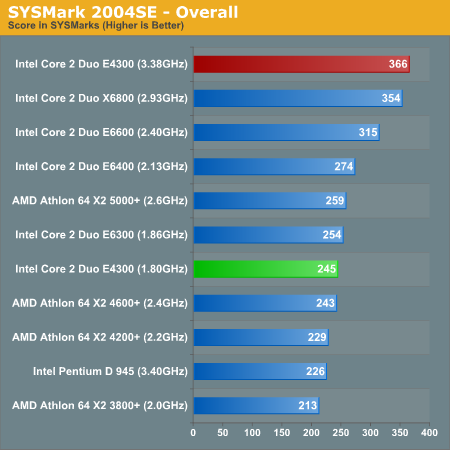
Overclocked, the E4300 truly shines - outpacing the X6800 by a marginal 3.3%. The margin of victory is well within the variance for SYSMark but the point to take home is that we're looking at an overclocked $163 chip, delivering performance equal to a CPU priced at six times its cost.
Internet Content Creation performance reflects what we saw in the overall score - the E4300 is within striking distance of the E6300, and of course faster than AMD's Athlon 64 X2 3800+. When overclocked, the E4300 can give you better performance than a X6800, this time coming in 11% faster.
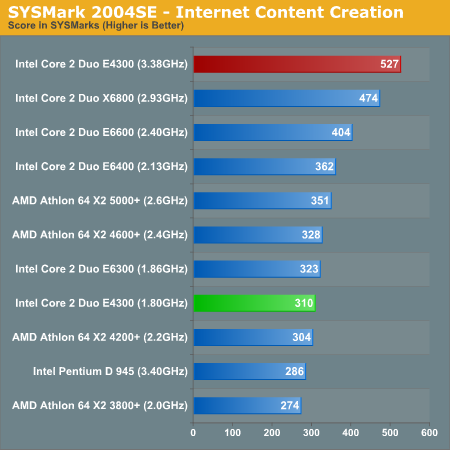
The Office Productivity suite changes things a bit; while the E4300 continues to perform similarly to the E6300, when overclocked it's still slower than the X6800 despite the clock speed advantage. There are many applications and usage models that will end up favoring more cache over a higher clock speed, and that's where the E4300 will lose out to its more expensive alternatives. At the end of the day, it's still a great value, but keep in mind that the smaller cache will limit maximum performance in some areas.
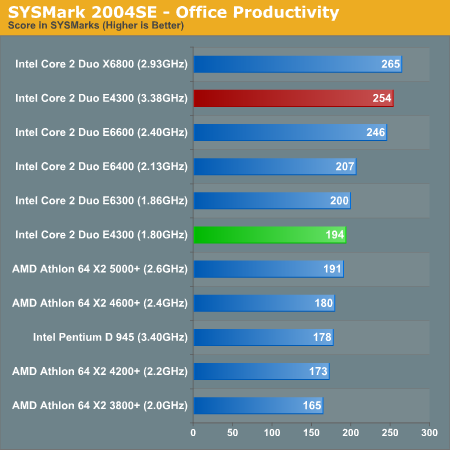
3D Rendering Performance
3dsmax 8 performance continues the performance trends we've seen; at default speeds the E4300 is slightly outperformed (2.5%) by the E6300, while it is around 14% faster than the Athlon 64 X2 3800+. Performance standings change a bit under Cinebench where AMD does better, with the X2 3800+ and E4300 offering similar performance.
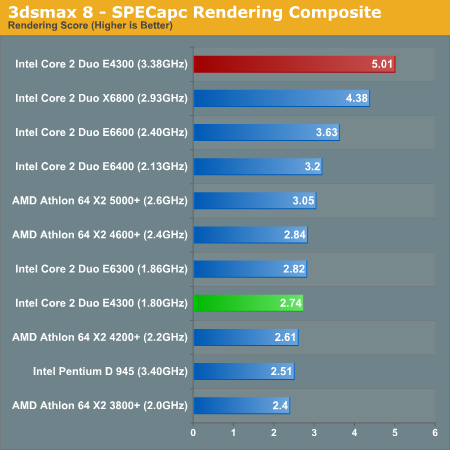
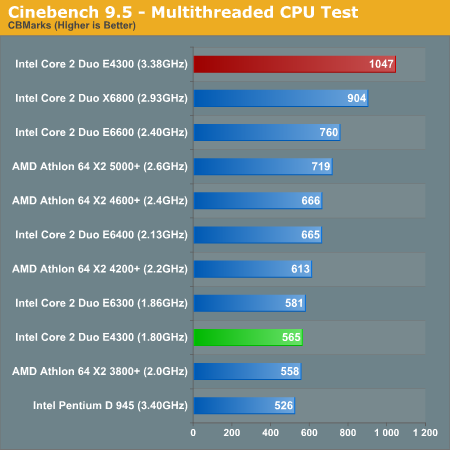
With 3D rendering depending largely on raw CPU speed, it's not surprising to see the overclock help out even more in these two benchmarks. The overclocked E4300 is 14-16% faster than the X6800, with a clock speed advantage of 15%. Larger caches and faster bus speeds only have a minimal impact here.
Encoding Performance
At default clock speeds, the Core 2 Duo E4300 completed our DivX test in the same amount of time as AMD's Athlon 64 X2 5000+. Overclocked, the E4300 has a 11% advantage over the X6800.
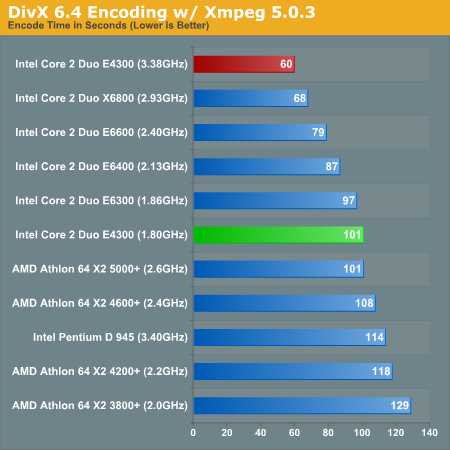
Windows Media Encoder is far more favorable to AMD CPUs and thus the E4300 ends up being a little slower than the X2 4200+. Our overclocked chip ends up, once again, on top of the charts.
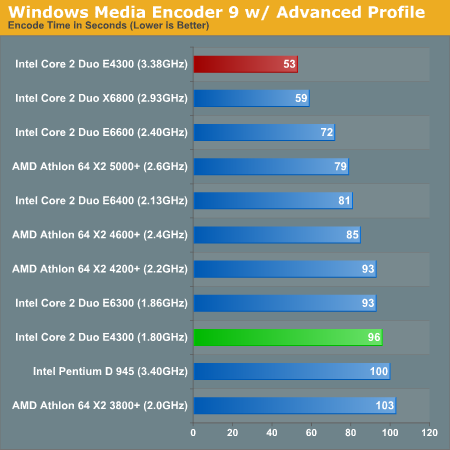
MP3 encoding performance is quite competitive, with the E4300 offering performance similar to the X2 4600+ and the E6300. Overclocked performance is once again competitive with the X6800.
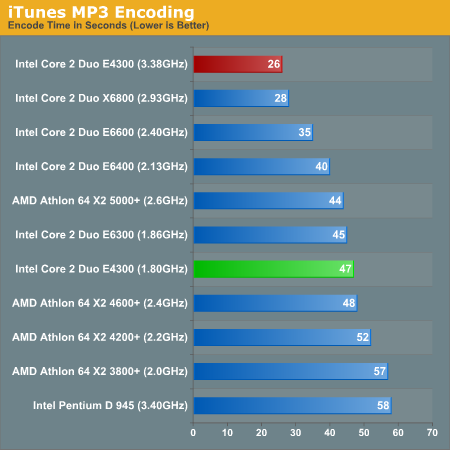
Gaming Performance
Quake 4 performance is reasonably close to the E6300, but when overclocked it can't quite outpace the X6800. The X6800 manages to hold onto a 12% performance advantage even with the E4300 holding onto a clock speed advantage. At stock speeds the E4300 offers similar performance to the Athlon 64 X2 3800+.
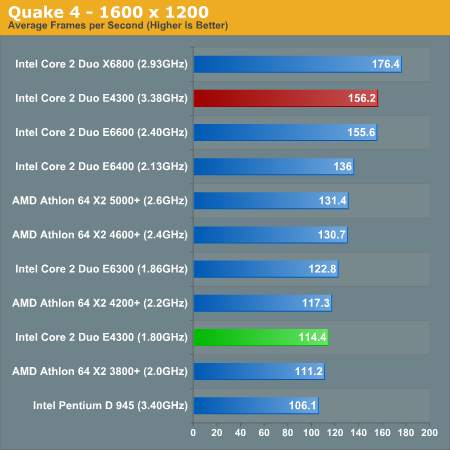
Oblivion has always been friendlier to Intel's Core 2 architecture, and thus the E4300 has no problems outpacing the X2 3800+. Compared to the similarly priced Pentium D 945, the E4300 is significantly faster, as the Pentium D's NetBurst architecture has rarely been favored in games. Overclocked, the E4300 gets close to the X6800 but it is no faster.
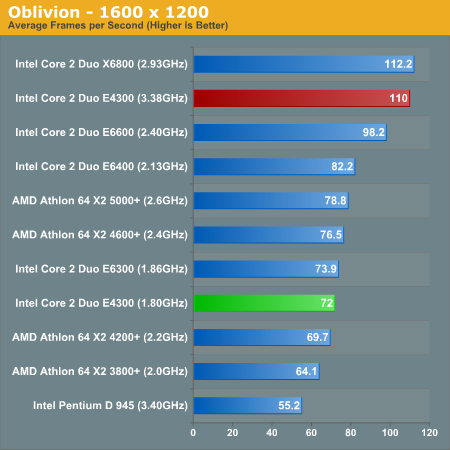
Half-Life 2: Episode One echoes what we've seen from our other gaming tests - at stock speeds the E4300 is faster than the X2 3800+ and slightly slower than the E6300. When overclocked to 3.38GHz, the E4300 ends up getting close to the performance of the X6800 but it cannot surpass it due to the smaller L2 cache.
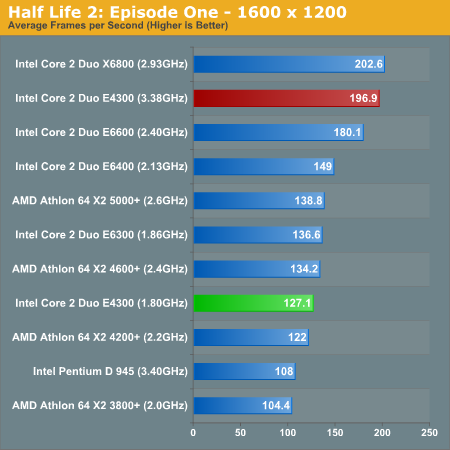
Power Consumption
We looked at power consumption of our two testbeds, however AMD is at a bit of a disadvantage here. While our Intel testbed uses the P965 chipset, the AMD testbed uses NVIDIA’s nForce 590 SLI, a far more power hungry platform. The results below are thus better for comparing within platforms and not necessarily useful for drawing AMD vs. Intel comparisons. Note that we did use AMD’s latest 65nm Brisbane core for all of our tests.
At idle we can see that the E4300 system already uses less power than the E6300, and definitely less power than the Pentium D 945.
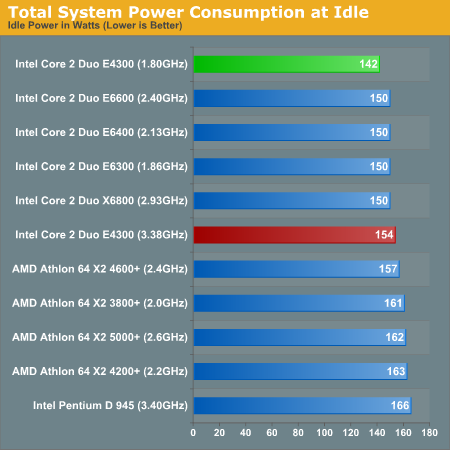
Under load, power consumption is once again reasonable - lower than the E6300. Overclocked, the E6300 uses a bit more power than the X6800 but that’s to be expected.

Final Words
Every generation a ridiculously overclockable bargain chip is born, and the Core 2 Duo E4300 is just that chip. Although it's not yet launched, Intel has a true winner on its hands with the E4300. Last year we saw overall desktop performance redefined by the Core 2 lineup, and in 2007 it looks like Intel will begin changing what we've come to expect in the sub-$200 CPU market. What's even more impressive is that in another quarter, the E4300 will drop even further to $133. At these prices you can build a second or third system with some very strong performance, at a very reasonable price tag.
The best part of it all is that the E4300 is a no-compromise core; you end up losing VT support, but all of the performance elements are there. The 800MHz FSB isn't crippling enough to really hinder performance, and the smaller cache is more than acceptable for the vast majority of applications. The Core 2 Duo E4300 is no Celeron; if anything it's a spiritual successor to a long line of attractive, highly overclockable Intel CPUs. It's everything Intel's Pentium D 820 was, but with much higher performance and a much lower power envelope.
At default speeds, the E4300 isn't all that impressive in the grand scheme of things; it's effectively a slightly cheaper, slightly slower E6300. But much like the E6300, much of the appeal of the E4300 comes from overclocking - and overclock it does. Compared to other Core 2 CPUs, the E4300 doesn't set any new overclocking records but at the price it's a true bargain.
The change in base FSB speed also has advantages in overclocking, making it possible to use a linked (1:1 ratio) memory speed and still get extremely high overclocks without resorting to anything more than DDR2-800 memory. The E6300 has a 7x multiplier and a 266 MHz base bus speed, so without dropping to a 4:5 ratio and sticking with DDR2-800, the E6300 tops out at 7x400 or 2.8 GHz. With a 9x multiplier the E4300 can potentially reach as high as 9x400 or 3.6 GHz while keeping memory at or below DDR2-800. While it is possible to get bus speeds of P965 motherboards above 500 MHz, it is far more difficult and often requires more expensive component choices, making the E4300 the new king of budget overclocking. Throw in a more powerful CPU cooling setup, and we have no doubt it will be very easy to exceed our 3.37GHz overclock by a large margin.
At stock speeds, the E4300 ends up offering similar performance to the Athlon 64 X2 4200+. In SYSMark 2004SE, DivX and some games it's faster, and in other situations it's basically the same speed. The Athlon 64 X2 3800+ ends up being slower in every benchmark, but with a lower price it's still a reasonable choice. Obviously the Core 2 upgrade path is a bit more desirable these days than AMD's Socket-AM2 platform, so the E4300 gets the nod there, but you can't really go wrong with either chip at default settings. When overclocked things get a little more complicated, but the E4300 gets the recommendation as a 2.8 - 3.0GHz Athlon 64 still ends up being slower than a 3.38GHz Core 2.
Compared to Intel's other value offerings, mainly the existing Pentium D lineup, the decision is clear. With the E4300 at $163 and moving down to $133 by Q2, cheap no longer means NetBurst. Intel is planning on significantly ramping its dual core presence this year, and with the E4300 available as a part of the lineup we can see exactly how. If you're building a Vista system early this year and want to do it efficiently, Intel is going to make it even cheaper to do.







